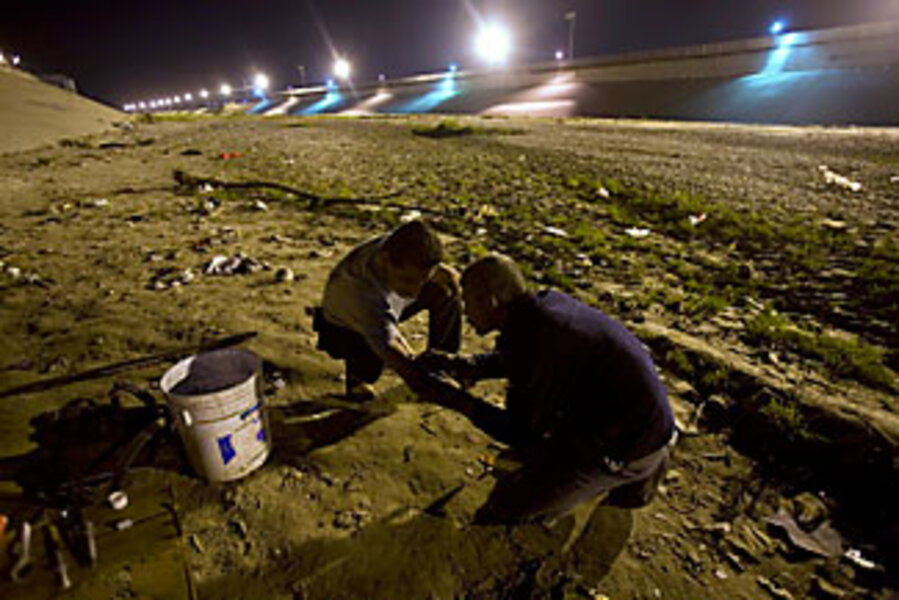Mexico's next war on drugs
Loading...
| Mexico City
Gerardo Flores was 16 when he first was offered marijuana, and by the time he was 19 he had tried ecstasy, LSD, and cocaine. He had been arrested for stealing and expelled from school.
This is the new face of drug addiction in Mexico.
Today the country finds itself not just in a battle with drug traffickers vying for lucrative routes into the US, but with a domestic consumption problem that is ensnaring youngsters such as Mr. Flores. Fortified borders and a fracturing of drug cartels have led to a glut of drugs in Mexico, causing prices to drop and addiction rates to skyrocket. The number of addicts has grown in just six years by more than 50 percent, from 300,000 to 465,000, according to government statistics.
"There's been a big change in society; consumers are as young as 10 years old," says Lina Raquel Sotres, a social worker and head of a government-run recovery clinic in Mexico City. "All of the drugs that aren't accepted up north are consumed here. The drugs get used one way or another."
Mexico is the main transit point for drugs from South America: Roughly 90 percent of cocaine consumed in the United States goes first through Mexico, according to the US State Department.
Stricter US border enforcement, particularly after 9/11, means that drugs are more available – in corner stores, outside schools, in dance clubs, even at all-night flower stalls. "The border was closed," says Marcela Lopez Cabrera, the director of a private recovery clinic called Monte Fenix in Mexico City, "and the drugs stayed in Mexico."
And many experts say that as the government has cracked down on cartels, they have splintered, generating more dealers, especially at lower levels. Often those dealers are paid not in dollars but in drugs, says Haydee Rosovsky, the former head of Mexico's commission on addiction.
More availability means cheaper drugs. These days the price of a gram of cocaine is between 150 and 200 pesos ($11 to $15), says Benjamin Garcia, who works at Monte Fenix, while crack is a tenth of that. In the early 1990s, the price of cocaine was nearly three times as expensive.
"You can get it anywhere," says Flores, who, as a junior high student, had a network of friends from whom he could buy drugs.
Cocaine use has steadily increased over the past decade, while crack use has exploded in the past few years. Methanphetamine consumption is a growing public health concern, too, particularly in the border towns of Ciudad Juárez and Tijuana, says Ricardo Sanchez, who heads the research department for a network of 110 government clinics that treat addiction.
The percentage of those who have tried drugs at least once in their life rose from just over 5 percent in 2002 to 6 percent last year, or by 1 million users. Each year they are younger, says Mr. Sanchez.
Blanca Garibay and her husband Rodolfo Garcia moved to Mexico City three years ago from a tiny town, and their teenage son immediately became friendly with local sellers. On a recent day they sat in a government-run treatment center waiting for their son – who did not show up. "It's frustrating, one day you advance, the next you regress," says Ms. Garibay. "I worry every day about what this will lead to, if it will lead to jail.... I do regret moving here and think about moving somewhere where drugs aren't so accessible."
But drugs are starting to appear across Mexico, and one reason is the increased deportation of migrants who lived in the US. For example, says Sanchez, in 2002, the agency began to hear cases of heroine use in Puebla, Mexico, the hometown of many New York immigrants.
While the government has allocated most of its resources to combating the supply side of the problem, it is now focusing on prevention and addiction, opening up more than 300 clinics. It's not enough, says Ms. Rosovsky. "There had been a kind of institutional denial in the past."
But clinics alone will not solve the problem. There is a dearth of trained professionals, says Ms. Lopez Cabrera. Her clinic offers two-year courses for doctors and nurses in drug addiction treatment. But the supply of drug counselors pales in comparison with the numbers needing help.
And stigmas continue to stand in the way of treatment. Ms. Sotres says that many parents come to her clinic unable to accept the fact that their children have addiction problems.
Garibay is confronting her son's problem head-on, but has not told her family about it. She says: "I'm afraid of the rejection, what they'll say about us."





